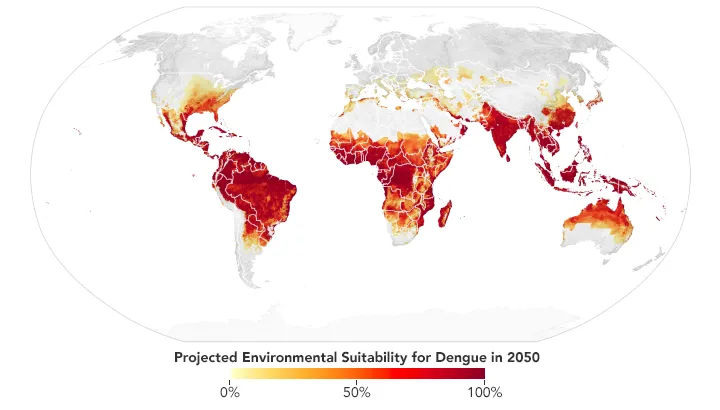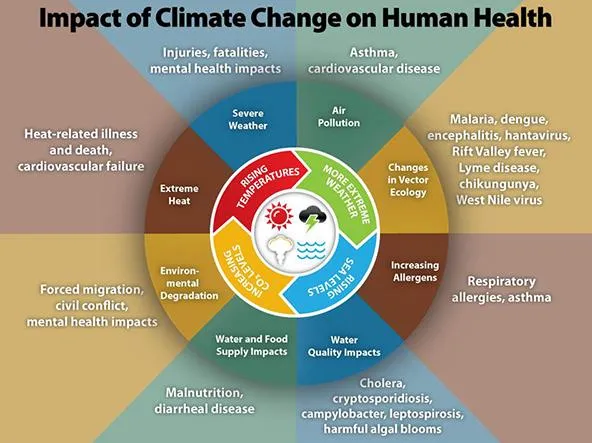Impacts of Climate Change on Human Health
Health impacts of climate change are already happening, and recent reports indicate they are worsening. Climate change affects human health and well-being in several ways:
- Extreme events: There is evidence that natural events such as heat waves, droughts, and storms are becoming more common and/or more intense as Earth’s climate warms. These events pose risks to human health. More of them, or more intense events, increase overall impacts on human health.
- Vector-borne diseases: Mosquitoes and other animals that carry infectious diseases like malaria from place to place (person to person) can only flourish in certain environments. As regional climates shift, the geographic distribution of these “vectors” changes as well.
- Water and human health: The rates of both water-borne diseases (resulting from unclean water) and water-washed diseases (resulting from lack of washing where water is scarce) are expected to increase as climate continues to change.

Extreme Weather Events Affect Human Health
Heat waves, floods, droughts, wildfires, and severe storms can cause injuries or deaths in the locations that are affected. As climate change increases the frequency and intensity of extreme weather events, more people will be affected by these hazards.
In the US, the Centers for Disease Control and Prevention (CDC) reports that heat waves can double or triple the number of deaths per day, and an increase in frequency and duration of heat waves due to climate change means the number of heat-related deaths is on the rise.
Habitats Expand for Disease-Carrying Organisms
A changing climate can expand the habitats that disease-carrying organisms require to survive. For example, the ticks that carry Lyme disease are now found in parts of Canada that were, not long ago, thought to be too far north for the ticks to survive. And in Bolivia, where the changing climate has caused more rainfall, the number of mosquitoes that carry dengue fever has soared.
In 2019, climate-sensitive diseases, including malaria, were estimated to contribute to nearly 70% of deaths across the planet. Heart-related diseases due to heat and other climate factors account for a large part of this number, but region-specific diseases are also an important contributor. For instance, Africa accounts for 92% of global deaths due to malaria, a disease spread by the Anopheles mosquito, whose habitat range depends on climate. Asia currently experiences 96% of the world’s deaths from dengue fever, which is spread by the Aedes aegypti mosquito. Both diseases are projected to impact a much larger percentage of the global population as the mosquitoes' habitat ranges expand due to climate change.

Projected 2050 habitat for the Aedes aegypti mosquito, responsible for transmitting dengue fever. As the climate warms, large parts of the southeastern US, central Mexico, central and southern Africa, coastal China, and Japan could become favorable environments for dengue fever.
NASA Earth Observatory map by Lauren Dauphin based on data from Janey Messina, University of Oxford
There have also been changes in plant distributions and types and duration of pollen, such as ragweed, that cause seasonal allergies. More carbon dioxide in the atmosphere promotes plant growth and can result in more pollen production. The warming climate also extends the growing season in some areas, which increases the number of days with high pollen concentrations. Airborne allergens degrade both outdoor and indoor air quality and can cause respiratory problems, such as asthma.
Lack of Clean Water Causes Outbreaks of Disease
Extreme rainfall events can cause outbreaks of water-borne diseases. Infection with water-borne pathogens is higher during the rainy season and after extreme rainfall events as blocked drains, flooded sewers, and other compromised systems create standing water in places where people live.
But drought or dry conditions do not mean you are safe either; transmission of water-borne diseases can also be higher in the dry season. During periods of low water flow in the Amazon, for example, cholera outbreaks are more likely because stagnant water allows more pathogens to thrive. In hot and arid regions of the world, people are also more likely to suffer from higher rates of water-washed diseases related to contaminated or insufficient water supply.
Combined Impacts Worsen Health Risks
Many of the health impacts of climate change are the result of combined impacts, where one factor worsens the effect of another factor. Examples include severe or long-lasting drought, which can make it difficult for communities to produce their own food. Changing precipitation patterns due to climate change can ultimately lead to malnutrition in drought-affected regions. Another example is declining air quality, which is likely to worsen in a warming world. The poor air quality, related to increased urban heat island effects, wildfire smoke, and other impacts of climate change, can in turn cause more cardiorespiratory problems.

The impacts of rising temperatures and other climate drivers (shown in the inner circle) can combine with other factors to cause multiple issues for human health and well-being.
Centers for Disease Control and Prevention
Additional human health impacts linked to climate change include:
- Increased cases of heart disease caused by extreme heat or poor air quality
- Higher numbers of respiratory diseases from air pollution
- Food shortages and food insecurity due to changing precipitation
- Increased mental health risks due to climate impacts on livelihoods, migration, and conflict
Unequal Vulnerability
Not all locations will be affected by extreme events in the same ways. Between 2010 and 2020, highly vulnerable regions experienced 15 times more human deaths from floods, droughts, and storms compared to regions with very low vulnerability. Human vulnerability to climate change is particularly high in certain parts of the world, including West, Central, and East Africa, South Asia, Central and South America, island nations, and the Arctic. Communities with fewer resources will often be both more at risk of climate impacts and also less able to adapt. You can think of it this way: as the climate continues to change, the people who are at the greatest risk of negative health impacts are also often those who have minimal resources to help improve the situation.
Certain populations, regardless of nationality, are more vulnerable than others. The urban poor, people who are very old or very young, traditional societies, subsistence farmers, and coastal populations are at the highest risk for health problems. Studies warn that although certain areas and populations can be more at risk, even wealthy countries with vast resources are currently not well prepared to cope with extreme weather events. Economic development alone cannot protect humans from disease and injuries due to climate change.
Adaptation
In some cases, the negative impacts on human health can be lessened if appropriate infrastructure and systems are put in place. In other words, in some ways, we can adapt. For example, the French government recently put a system in place to warn people of heat wave danger and to make sure the elderly, who are particularly vulnerable, are given special care in the event of a heat wave. Improved evacuation plans for hurricane-prone regions, improved water treatment and sewer facilities, and other improvements can make a difference for human health.
The solutions to climate-related health impacts are challenging, but one conclusion from the Intergovernmental Panel on Climate Change (IPCC) is that “climate solutions are ‘win-win-win’ actions, benefiting not just the planet but also our health and the economy.”
Resources
More information is available in the following reports: